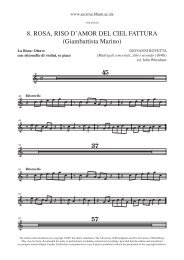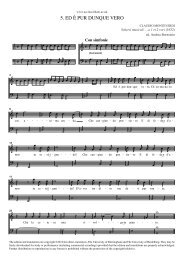Monteverdi Scherzi Musicali 1632 - University of Birmingham
Monteverdi Scherzi Musicali 1632 - University of Birmingham
Monteverdi Scherzi Musicali 1632 - University of Birmingham
- No tags were found...
Create successful ePaper yourself
Turn your PDF publications into a flip-book with our unique Google optimized e-Paper software.
www.ascima.bham.ac.ukxfirst operatic essay, Orfeo, and they remained part<strong>of</strong> his vocabulary throughout the remainder <strong>of</strong> hiscareer.’ 7It may be that it was the success <strong>of</strong> the 1628<strong>Scherzi</strong> reprint that prompted Magni to choose thesame title for his <strong>1632</strong> collection <strong>of</strong> <strong>Monteverdi</strong>’ssolo songs and duets. As with the publication<strong>of</strong> the Lamento d’Arianna in 1623, we have noknowledge <strong>of</strong> the extent to which <strong>Monteverdi</strong> wasinvolved in the collection and publication <strong>of</strong> the<strong>1632</strong> <strong>Scherzi</strong>, the dedication <strong>of</strong> which was signedby Magni on 20 June <strong>1632</strong>. As Paolo Fabbri haspointed out, <strong>Monteverdi</strong> was away from Venice forsome months until at least 20 August <strong>1632</strong>, andmay in any case not have wished to be too closelyassociated with a volume <strong>of</strong> secular music, giventhat he had been created priest only on 16 April. 8 AsFabbri further observes, the <strong>Scherzi</strong> was one <strong>of</strong> onlyfour volumes <strong>of</strong> music published in Venice in <strong>1632</strong>following the disastrous plague years <strong>of</strong> 1630-31and Magni may have requested its contents from<strong>Monteverdi</strong> in the hope <strong>of</strong> stimulating a dormantmarket. 9The title-page <strong>of</strong> the <strong>Scherzi</strong> advertises ‘Arie’,‘Madrigali’ and a ‘Ciaccona’. The last <strong>of</strong> these,‘Zefiro torna e di soavi accenti’, is a setting fortwo voices <strong>of</strong> Ottavio Rinuccini’s reworking7. ‘The Mantuan Madrigals and <strong>Scherzi</strong> musicali’, inWhenham and Wistreich (eds), The Cambridge Companionto <strong>Monteverdi</strong>, 100.8. Fabbri, <strong>Monteverdi</strong>, trans. Carter, 226.9. Idem, 227-28.«Cruda Amarilli» – che indicarono le strade futureda percorrere: essi fornirono un modello strutturalesul quale <strong>Monteverdi</strong> basò le forme del suo primosaggio operistico, Orfeo; forme che rimasero nelsuo vocabolario per il resto della sua carriera». 7Forse fu proprio il successo della ristampa degli<strong>Scherzi</strong> nel 1628 che diede il destro a Magni diimpiegare lo stesso titolo per la raccolta di canzonisolistiche e duetti pubblicata nel <strong>1632</strong>. Cosìcome successe per la pubblicazione del Lamentod’Arianna nel 1623, non sappiamo quanto<strong>Monteverdi</strong> sia stato coinvolto nella preparazionee pubblicazione degli <strong>Scherzi</strong> del <strong>1632</strong>, ancheconsiderando che la loro dedica fu firmata daMagni il 20 giugno di quell’anno. Come fa notarePaolo Fabbri, <strong>Monteverdi</strong> fu assente da Veneziaper qualche mese almeno fino al 20 agosto <strong>1632</strong>,e probabilmente non desiderava essere troppocoinvolto con un volume di musica pr<strong>of</strong>ana, dalmomento che era stato ordinato sacerdote pocoprima, il 16 aprile. 8 Come inoltre osserva Fabbri, gli<strong>Scherzi</strong> furono uno dei soli quattro libri di musicapubblicati a Venezia quell’anno, che seguiva ilperiodo della tremenda epidemia di peste del 1630-31. Dunque Magni potrebbe aver richiesto quelle7. «The Mantuan Madrigals and <strong>Scherzi</strong> musicali»,in Whenham and Wistreich (a cura), The CambridgeCompanion to <strong>Monteverdi</strong>, 100.8. Gastone Vio, «Ultimi raguagli monteverdiani», Rassegnaveneta di studi musicali, 2-3 (1986-7), 347-64, spec. 350. Idocumenti relativi all’ordinazione furono ritovati solo dopola pubblicazione del saggio di Fabbri.progressivsten seiner weltlichen Werke. Wie vonMassimo Ossi erwähnt wurden «die <strong>Scherzi</strong> – nichtMadrigale wie “Cruda Amarilli” – zukunftsweisendfür <strong>Monteverdi</strong>s Entwicklung: sie bildeten diestrukturelle Basis für die Formen von Orfeo,<strong>Monteverdi</strong>s erstem Ausflug in die Opernwelt, undblieben für den Rest seiner Karriere Bestandteilseines Vokabulars». 7Möglicherweise wurde Magni durch denErfolg der neu aufgelegten <strong>Scherzi</strong> von 1628 dazuangeregt, für seine Sammlung von Solostückenund Duetten <strong>Monteverdi</strong>s im Jahre <strong>1632</strong> denselbenTitel zu wählen. Wie bei der Veröffentlichungdes Lamento d’Arianna 1623 ist nicht bekannt,in welchem Maße <strong>Monteverdi</strong> an der Sammlungund Veröffentlichung der <strong>Scherzi</strong> von <strong>1632</strong>,deren Widmung am 20. Juni <strong>1632</strong> von Magniunterschrieben wurde, beteiligt war.Wie von PaoloFabbri erwähnt hatte <strong>Monteverdi</strong> Venedig für einigeMonate (mindestens bis zum 20. August <strong>1632</strong>)verlassen und mag in jedem Fall nicht gewollthaben, dass er – so kurz nach seiner Weihung zumPriester am 16. April – zu eng mit einem Bandweltlicher Werke assoziiert wurde. 8 Fabbri betontebenso, dass die <strong>Scherzi</strong> zu den insgesamt nur vierMusikbänden gehörten, die <strong>1632</strong> in den Jahrennach der entsetzlichen Pestepidemie von 1630-31veröffentlicht wurden. Magni mag den Inhalt von7. The Mantuan Madrigals and <strong>Scherzi</strong> musicali, in: TheCambridge Companion to <strong>Monteverdi</strong>, S. 100.8. Fabbri, <strong>Monteverdi</strong>, englisch Übersetzung von TimCarter, S. 226.








